fine arts, health, physical education (391)
1/238
There's no tags or description
Looks like no tags are added yet.
Name | Mastery | Learn | Test | Matching | Spaced |
|---|
No study sessions yet.
239 Terms
body awareness
the ability to understand where your body is in space.
Directional awareness
the ability to understand the concepts of left and right, up and down, top and bottom, front and back, and in and out.
Spatial awareness
an awareness of oneself and other objects in space
Temporal awareness
the ability to judge movement and time.
Movement exploration
an active-learning strategy that helps students use their bodies to develop various skills and concepts, including hand-eye coordination, spatial awareness, and balance
Perceptual-motor development
combines a child's sensory skills (brain) and motor skills (body) to synchronize body movements
Locomotor skills
involve moving the body from one location to another.
non-locomotor skills
involve moving the body while remaining stationary.
manipulative skills
help students learn to handle and move objects. (throwing, catching)
Closed skills
skills that occur in a stable, predictable setting.
(performing squats, serving in tennis)
Open Skills
skills that are affected by the setting
Rhythmic awareness
help students sense and perform patterns of sound and motion.
Mature motor patterns
require students to exercise a combination of locomotor, non-locomotor, and/or manipulative skills while also exhibiting body, spatial, and/or rhythmic awareness.
walking
one foot remains in contact with the ground
stance
contact, midstance, propulsion (60% of gait cycle)
contact
from heel strike to flat foot
midstance
from flat foot to heel lift
propulsion
from heel lift to toe off
swing phase
begins when the foot leaves the ground after toe-off and is propelled forward (40% of gait cycle)
flight phase
booth feet leave the ground
supporting role
making contact with the ground
recovery role
not making contact with the ground
knee flexion of a jump
60-90
angle take off of a jump
45
flight phase of jump
when theyre in the air
in what direction are hips when throwing
counterclockwise
striking
using a piece of equipment to apply force to an object and move it through the air or on the ground.
underhand
striking an object that is below the wais
punting
involves striking an airborne ball with the foot.
dribbling
controlling the ball with either hands on feet
volleying
coordinating various body parts to strike an airborne ball or object
body composition
describes the percentage of fat, bone, water, and muscle that make up our bodies.
Body Mass Index
a measure of body fat based on height and weight
bmi underweight
less than 5 percentile
healthy bmi
5-89 percentile
overweight bmi
85-94 percentile
obese percentile
95+ percentile
skinfold thickness
in which a caliper is used to measure the thickness of the subcutaneous fat in the body in the abdomen, arms, buttocks, thighs
hydrostatic testing
underwater weighing through displacement
agility
ability to move quickly and easily
power
the capacity to move an object
balance
the ability to remain upright
coordinate
the ability to manipulate movement
anaerobic exercise
short bursts of exercise so intense that your muscles are temporarily deprived of oxygen
physical endurance
the ability to move the body or an object repeatedly without becoming fatigued
cardiorespatory endurance
the ability of the cardiac and respiratory systems to take in, transport, and consume oxygen while performing physical activities
aerobic exercise
require active, vigorous movements will help improve cardiorespiratory endurance.
SMART
Specific, Measurable, Achievable, Relevant, Time-bound
kinesthetic feedback
involves the teacher manipulating the individual so they can experience the "feel" of the proper form
fundamental movement skills
the foundation of physical activity and movement.
precision request
structured, precise messages that increase the likelihood of student compliance.
verbal mediation
have the student state out loud the association between their actions and the consequences of their actions.
proprioceptive sensory systems
allows us to sense the relative position of the various parts of the body and to apply the appropriate amount of force to objects and movements. This information is unconsciously relayed to the brain from our muscles and joints.
vestibular systems
allows us to balance the body and orient ourselves within space.
discriminative system
allows us to sense and avoid potentially harmful sensatio
movement intolerance
fast movement or spinning causes dizziness and/or nausea.
hyposensitive
under responsiveness to touch
poor tactile discrimination
the child cannot process information about how objects feel.
bluegrass music
Developed in Appalachia when settlers from the United Kingdom and Ireland began writing songs about their day-to-day life in their new home.
contra formation dance
Can be done in two lines where each line faces each other
scatter dance
encourages improv
Noble Duke of York
Two lines facing each other walk up to each other while singing the song. Choreography matches the words, then the head pair casts off and a new head pair becomes the leader.
Hello And How Are You
All dancers face a partner in the circle and sing "Hello And How Are You" while doing non-locomotor movements, then they use locomotor movements to pass their partner by taking a few steps forward in order to move to their new partner in the circle.
Bo Diddley
Head couple takes hands and sashays down the middle, partners take hands and circle around each other two times, head couple marches down the center of the set to the end of the line, all dancers move over one spot.
Rocky Mountain
Outside circle faces their partner in the inside circle, circles walk in opposite directions until they reach their partner again, patty cake clap pattern from low to high with their partner, upon repetition of the song go one dancer past your old partner to meet your new partner and repeat the non-locomotor movements.
Hokey Pokey
Dancers put different limbs "in" and "out" while staying in one place.
A Tisket, A Tasket uses
scat
the first lady of song
Ella Fitzgerald
first great jazz soloist
Louis Armstrong (trumpet)
Rock and Roll
combines elements from the blues and country music to form a new genre in the 1950s.
Hip Hop
highly rhythmic genre that often features samples from other songs and rhythmic vocals.
offical Texas song
texas our texas
kodaly concept
experience-based approach that emphasizes the pleasure of music and the importance of the human voice.
sight sing
sing a piece of music without having heard it before
Solfège
a system for singing notes
rote learning
students learn songs by ear
Staff
Set of five lines and four spaces. Each line and space represents a specific musical pitch
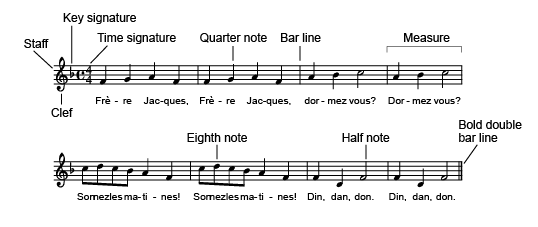
measures
notes that are grouped together in measures (or bars).
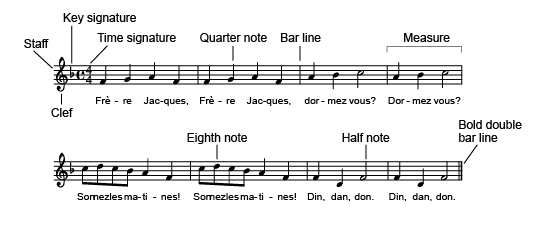
Clef
The French word for "key," indicates the pitch of the notes written on the staff, e.g. treble clef, bass clef.
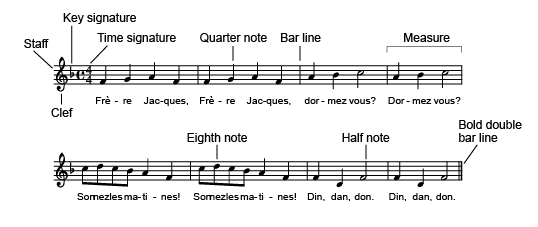
key signatures
Set of flats and sharps placed on the staff to indicate which notes should be performed at higher or lower pitches than their natural pitches on the staff.
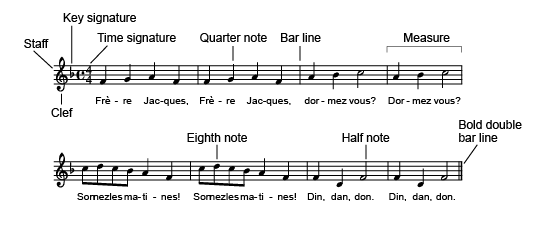
Time signature
Appears after the clef and key signature, tells you the meter that a piece of music uses.
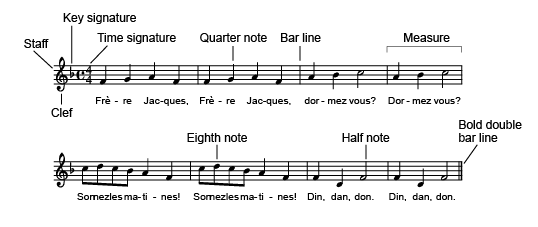
treble clef
every good boy does fine
bass clef
grizzly bears dont fly airplane
soprano
highest vocal range for women
mezzo soprano
middle vocal range for women
contralto
lowest vocal range for women
tenor
highest vocal range for men
baritone
the middle vocal range for men
bass
the lowest vocal range for men
woodwind instruments
Tubular instruments with a series of holes that can be opened and closed to change the pitch
brass instruments
a series of tubes
percussion instruments
Instruments that are shaken or hit to produce sound.
non pitched instruments
used to provide rhythm
intervals
the difference between two pitche
intonation
Accuracy in pitch when singing or playing an instrument
dynamics
How loudly or softly a performer should play or sing a passage - likely to be located below the music in the first measure
crescendo
to continuously increase volume
diminuendo
to continuously descreas volume
forte
to play or sing loudly
mezzo forte
to play or sing moderately loudly